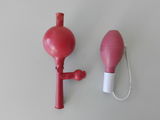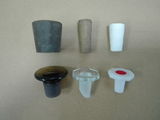Rubber
 |
This article is a stub. Please help Sciencemadness Wiki by expanding it, adding pictures, and improving existing text.
|
Rubber is a polymer displaying the property of elasticity.
There are two categories of rubber: natural rubber currently obtained from the rubber tree (Hevea brasiliensis) and synthetic rubber derived from petrochemicals.
Contents
Types and composition
There are two main types of rubber:
- Natural rubber: also called India rubber, latex, Amazonian rubber, caucho or caoutchouc, as initially produced, consists of polymers of the organic compound isoprene, with minor impurities of other organic compounds, plus water. Natural rubber is harvested mainly in the form of the latex from the rubber tree or other plants, such as Russian dandelion (kok-saghyz) or from guayule.
- Synthetic rubber: derived from petroleum, it is obtained by polymerizing single monomers, like 1,3-butadiene, isoprene or multiple monomers, like butadiene and styrene.
- Silicone rubber: elastomer composed of polymeric organosilicon compounds. Technically correct term for the various silicone rubbers is polysiloxanes or polydimethylsiloxanes. It is commonly used in areas where chemical and thermal resistance is required.
Properties
Raw natural latex is a white thick liquid, that solidifies in open air. It can be kept liquid if preserved in ammonia, which inhibits its polymerization. Polymerized latex is a white or yellow-brownish elastic solid material, insoluble in most solvents. It will be attacked by strong oxidizers, like ozone as well as strong UV light.
Synthetic rubber is more readily attacked by common solvents and has a similar chemical resistance to corrosive reagents like the natural variety.
Rubber begins to melt/decompose at approximately 180 °C
Natural rubber is an elastomer and a thermoplastic. Once the rubber is vulcanized, it is a thermoset.
Vulcanization of rubber creates di- and polysulfide bonds between chains, which limits the degrees of freedom and results in chains that tighten more quickly for a given strain, thereby increasing the elastic force constant and making the rubber harder and less extensible.
Silicone rubber is generally non-reactive, stable, and resistant to extreme environments and temperatures from −55 to 300 °C. Silicone rubber has low tensile strength, poor wear and tear wear properties. Some properties such as elongation, creep, cyclic flexing, tear strength, compression set, dielectric strength (at high voltage), thermal conductivity, fire resistance and in some cases tensile strength can be—at extreme temperatures—far superior to organic rubbers in general, although a few of these properties are still lower than for some specialty materials. It also resists the chemical attack of many solvents, acids and oxidizers, though halogens and nitric acid/nitrogen dioxide will corrode it.
Availability
Rubber can be found in many common items, like tubing, gloves, clothing, hardware parts, etc. Sheets or bars of rubber can be bought from online suppliers, both the natural or the synthetic variety.
Liquid latex can be bought online.
Projects and uses
- Protection gloves
- Water cooling (tubing)
- Make an air vortex cannon
- Lab items
Handling and safety
Rubber is not edible so don't eat it. Rubber may cause serious latex allergy in some people, and exposure to natural latex rubber products such as latex gloves can cause anaphylactic shock, due to the presence of antigenic proteins. Synthetic rubber or natural rubber from other sources (like guayule) is recommended as replacement.
It's also not very flammable, but once ignited, it will burn releasing enormous amounts of black smoke, which contains lots of soot and it's very harmful.


